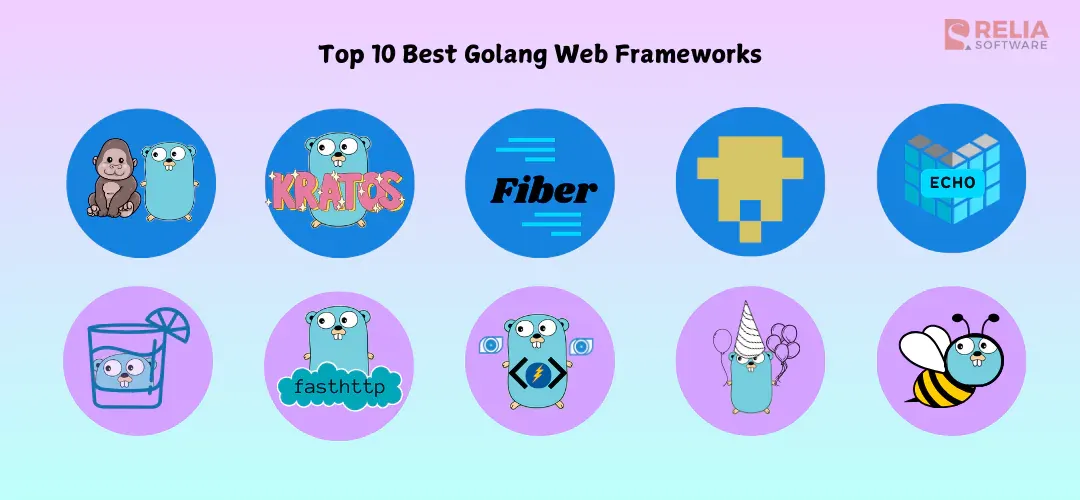Golang (or Go) is an open-source compiled programming language that is used to create software that is simple, methodical, and secure. It was created by Google in 2007 and has been widely accepted by developers worldwide due to characteristics such as memory safety, structural typing, garbage collection, and resemblance to C-language.
So, in this article, I review the top 10 best Golang web frameworks that you should consider in your web application development.
>> Read more about Golang:
- Top 6 Best Golang Testing Frameworks in 2025
- Best Practices For Dependency Inversion in Golang
- Type Conversion in Golang: How To Convert Data Types in Go?
- Golang Memory Leaks: Identify, Prevent, and Best Practices
What are Golang Web Frameworks?
Golang web frameworks are collections of pre-written code used to quickly create application programming interfaces (APIs) and web services. Frameworks are not needed in developing tiny applications but are required in developing production-level software.
You know, writing and debugging a production-level application takes a lot of time, even with the right tools and knowledge. That’s why developers often use frameworks. They provide built-in features and services that make it easier to add common functionalities without having to build everything from scratch.
Top 10 Best Web Frameworks for Golang
Gin/Gin-Gonic
Gin framework is built on top of HTTP router and middleware, providing features that simplify Golang web development. These features include request/response processing, routing, middleware, validation, logging, and more.
Gin shares the same API as Martini but is up to 40 times faster, making it a great choice for high-performance applications. Its simple and intuitive syntax allows developers to build complex web apps quickly. Gin is also an ideal Golang framework for REST API development.
Here’s a basic example of Gin - Golang web server framework that handles a GET request at the root path ("/"):
package main
import (
"fmt"
"github.com/gin-gonic/gin"
)
func main() {
router := gin.Default()
router.GET("/", func(c *gin.Context) {
c.String(200, "Hello, World from Gin!")
})
err := router.Run(":8080")
if err != nil {
fmt.Println("Error starting server:", err)
}
}
You can find a more comprehensive tutorial on the official Gin website: https://gin-gonic.com/
Beego
Beego is an open-source web framework for Golang, offering high performance and following the MVC (Model-View-Controller) design pattern. It supports the development of web applications, APIs, and backend services with built-in tools for routing, ORM, logging, and HTTP handling.
One of Beego’s strengths is its modular design, developers can use only the components they need. Its built-in libraries make tasks like database access, request handling, and logging easier.
>> You may consider: An Ultimate Guide for Structured Logging in Go with Slog
Here’s a simple example of a Beego web server that responds to a GET request at the root path ("/"):
package main
import (
"fmt"
"github.com/beego/beego/v2/routing"
)
func main() {
routing.HandleFunc("/", func(ctx *routing.Context) {
ctx.WriteString("Hello, World from Beego!")
})
err := routing.Run(":8080")
if err != nil {
fmt.Println("Error starting server:", err)
}
}
Find a more comprehensive tutorial on the official Beego website: https://beego.wiki/
Echo
Echo is a Golang framework for RESTful API design, known for its performance, flexibility, and simplicity. It can be used on its own or combined with other libraries like Gin.
Echo offers powerful features such as data binding and rendering, automatic TLS support, HTTP/2 compatibility, optimized routing, middleware support, and easy extensibility. These features make it a great choice for building high-performance web applications and APIs.
A simple code example for Echo framework:
package main
import (
"fmt"
"github.com/labstack/echo/v4"
)
func main() {
e := echo.New()
e.GET("/", func(c echo.Context) error {
return c.String(http.StatusOK, "Hello, World from Echo!")
})
err := e.Start(":8080")
if err != nil {
fmt.Println("Error starting server:", err)
}
}
For further information, you can access the official Echo website: https://echo.labstack.com/
Iris
Iris includes built-in support for MVC (Model-View-Controller) architecture, making it easy to manage large applications. It also comes with essential features like session handling, routing, and caching middleware. Additionally, it supports third-party libraries such as Passport, Express-Session, Body-Parser, and Morgan, so you can integrate them seamlessly into your projects.
Here's a basic example for how to create a simple web server with Iris that responds to a GET request on the root path ("/"):
package main
import (
"fmt"
"github.com/kataras/iris/v12"
)
func main() {
app := iris.New()
app.Get("/", func(ctx iris.Context) {
ctx.WriteString("Hello, World from Iris!")
})
err := app.Run(":8080")
if err != nil {
fmt.Println("Error starting server:", err)
}
}
For a more comprehensive tutorial, access the official Iris website: https://github.com/kataras/iris
Gorilla
The Gorilla web toolkit isn't a single framework, but rather a collection of reusable packages for building HTTP-based applications in Go. Gorilla solves various aspects of writing a web service: context, mux, and other libraries to implement cookies, sessions, WebSockets, and RPC over HTTP.
Many big names, including Netflix, use Gorilla for their web application development. It also has a series of useful features and is completely free to use. Gorilla is quite easy to use, with documentation provided in multiple languages.
Here's an example demonstrating a basic web server with Gorilla's mux (routing) package that responds to a GET request on the root path ("/"):
package main
import (
"fmt"
"net/http"
"github.com/gorilla/mux"
)
func main() {
r := mux.NewRouter()
r.HandleFunc("/", func(w http.ResponseWriter, r *http.Request) {
fmt.Fprintf(w, "Hello, World from Gorilla!")
})
fmt.Println("Starting server on port 8080")
err := http.ListenAndServe(":8080", r)
if err != nil {
fmt.Println("Error starting server:", err)
}
}
For a more comprehensive tutorial on using Gorilla packages, refer to the official documentation: https://github.com/gorilla
Revel
Revel is a Golang full-stack web framework that is different from others. It offers a self-sufficient environment with no extra setup, middleware, or third-party plugins required. It follows the Model-View-Controller (MVC) pattern and has built-in features like routing, parameter parsing, validation, session management, templating, caching, job scheduling, and more.
One of Revel’s standout features is Hot Code Reloading, which automatically detects file changes and recompiles the project, speeding up development.
As of April 2022, the latest release is version 1.1.0, and it requires Go version 1.17 or higher. While Revel is no longer actively developed, it still has resources and community support for those interested in using it.
Here's an example (note that some functionalities might require additional libraries):
package main
import (
"fmt"
"github.com/revel/revel/v1/controller"
"github.com/revel/revel/v1/routing"
)
type App struct {
*controller.Controller
}
func (c App) Index(cc *routing.Context) routing.RenderResult {
return c.Render("index", "Hello, World from Revel!")
}
func main() {
fmt.Println("Starting Revel server...")
routing.Run(":8080")
}
For a more comprehensive understanding, you can refer to some of the archived Revel documentation: https://github.com/revel/revel
Gocraft
Gocraft is a lightweight and flexible Golang framework for high-performance web applications. It features a fast router and built-in middleware, so you can extend functionality without extra dependencies. With low request latency (3-9 microseconds per request) and efficient tree-based routing, Gocraft is optimized for speed.
Besides web development, Gocraft has gocraft/work, a package for background job processing with Redis. It supports job retries, scheduling, and a web UI for monitoring tasks. While Gocraft is still useful, some components may not be actively maintained. You should check for community support before using it in new projects.
>> Read more: Implementing Pub/Sub in Go with Redis for Real-Time Apps
Here's a basic example demonstrating how to create a simple web server with gocraft/web that responds to a GET request on the root path ("/"):
package main
import (
"fmt"
"net/http"
"github.com/gocraft/web"
)
func main() {
router := web.New(web.Config{})
router.Get("/", func(c *web.Context) error {
return c.WriteString(http.StatusOK, "Hello, World from gocraft/web!")
})
fmt.Println("Starting server on port 8080")
err := router.ListenAndServe(":8080")
if err != nil {
fmt.Println("Error starting server:", err)
}
}
You can find a more comprehensive tutorial on the official gocraft/web GitHub repository: https://github.com/csells/go_router
Fiber
Fiber is a Golang web development framework similar to Express.js. Fiber provides capabilities such as low-memory operation and extensive routing. Built on top of the Fast HTTP engine for Go, Fiber is one of the fastest Golang frameworks.
Designed with minimalism and the Unix philosophy, it provides a simple yet scalable approach to web development. Fiber offers efficient routing, middleware support, and built-in WebSocket capabilities, making it ideal for modern applications. It also includes a built-in rate limiter to control traffic and enhance security.
Here's a basic example demonstrating a simple web server with Fiber that responds to a GET request on the root path ("/"):
package main
import (
"fmt"
"github.com/gofiber/fiber/v2"
)
func main() {
app := fiber.New()
app.Get("/", func(c *fiber.Ctx) error {
return c.SendString(http.StatusOK, "Hello, World from Fiber!")
})
err := app.Listen(":8080")
if err != nil {
fmt.Println("Error starting server:", err)
}
}
For a more comprehensive tutorial, you can refer to the official Fiber documentation: https://docs.gofiber.io/
Kratos
Kratos is a Golang framework for REST API and microservices with scalability and ease of use. It supports gRPC, HTTP, and Kubernetes, making it ideal for distributed systems.
With built-in service discovery, load balancing, and resilience features like circuit breakers and retries, Kratos helps developers build reliable services. It also includes code generation tools to simplify API and configuration setup, reducing manual work.
Kratos provides logging, tracing, and configuration management, so developers can focus on business logic instead of infrastructure. For a hands-on guide, visit the Kratos Official Documentation: https://go-kratos.dev/en/docs/
>> Read more: A Complete Guide to Implement Golang gRPC with Example
Fast HTTP
Fast HTTP is a high-performance HTTP server and client for Golang, designed as a faster alternative to net/http. It is optimized for speed and low memory usage, handling over 100k requests per second and more than 1 million concurrent keep-alive connections on modern hardware.
Fast HTTP supports automatic retries for failed idempotent requests and makes it easy to use Connection Upgrade via RequestCtx.Hijack. Its API is designed for flexibility, so developers can customize both server and client implementations as needed.
While net/http remains the standard due to its extensive testing and HTTPS support, Fast HTTP is a great choice for applications needing extreme performance. It also works alongside both net/http and fast/https.
Here's a link to the official documentation showcasing its functionalities: https://github.com/valyala/fasthttp
Factors to Consider When Choosing Golang Web Frameworks
Project size and complexity: Consider the scale and complexity of your project. A framework like Gin or Echo may be sufficient for small to medium-sized projects, while larger projects may profit from the comprehensive features offered by Beego or Revel.
Performance requirements: If performance is a top priority, frameworks like Gin, Echo, or Fiber, known for their speed and effectiveness, are good choices.
Ease of use: Evaluate the learning curve and ease of use of each framework. Beginners may find Gin or Echo more approachable, while more experienced developers may need the power of Beego or Revel.
Community and support: Consider the size of the framework's community. A strong community ensures ongoing support and regular updates.
Compatibility and integrations: Check if the framework works well with your database, ORMs, and third-party libraries. Make sure it integrates smoothly with the tools you plan to use in your project.
>> Read more: Top 13 Most Popular Web Development Frameworks in 2025
Conclusion
These are some of the most popular Golang frameworks our developers have worked with, but this isn’t a final list of the best. Many others can also help your application succeed.
>>> Follow and Contact Relia Software for more information!
- golang
- coding
- Web application Development
- development
- web development

